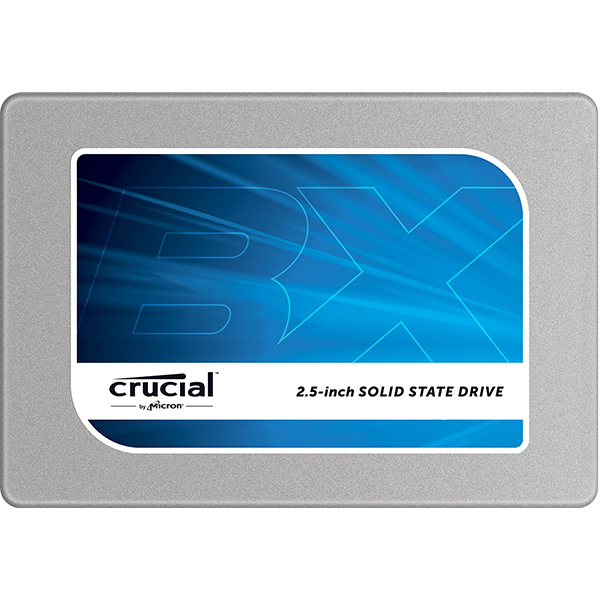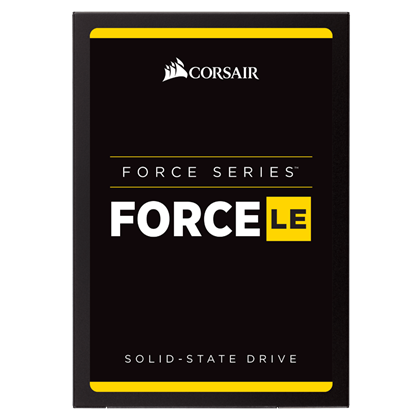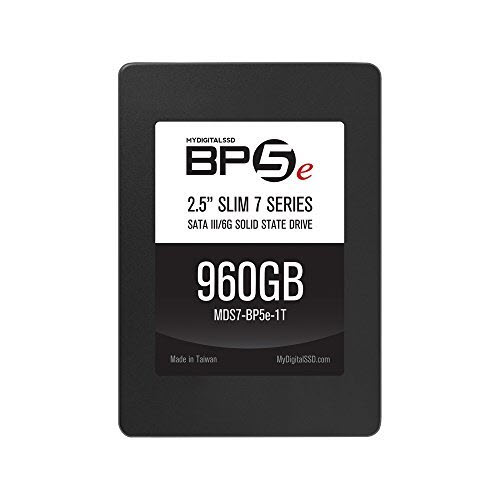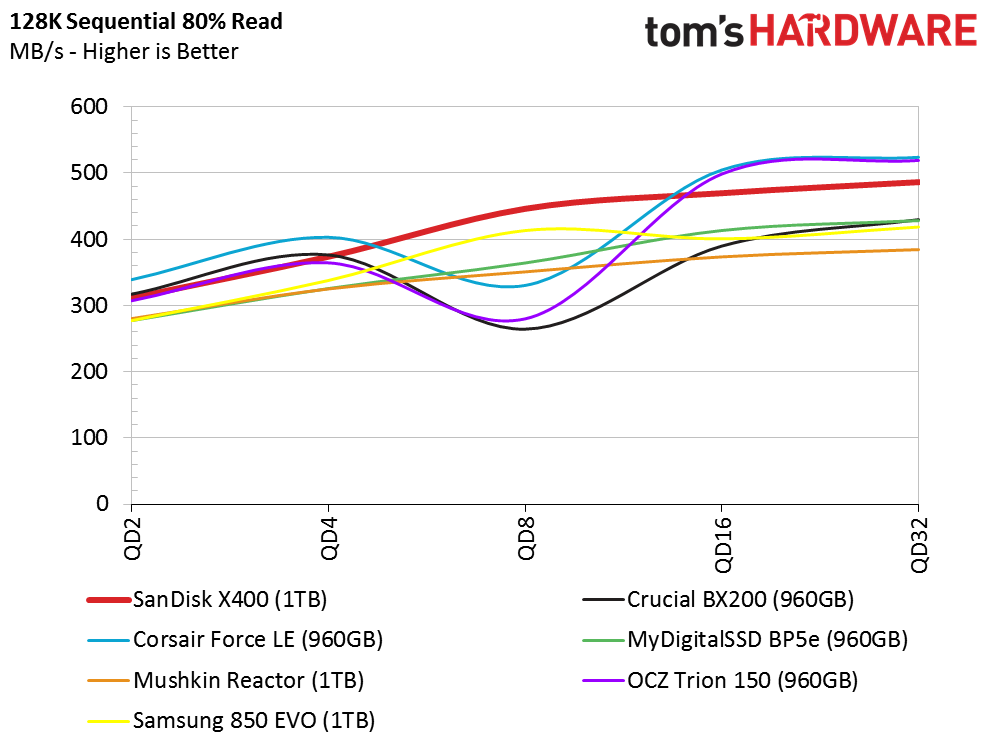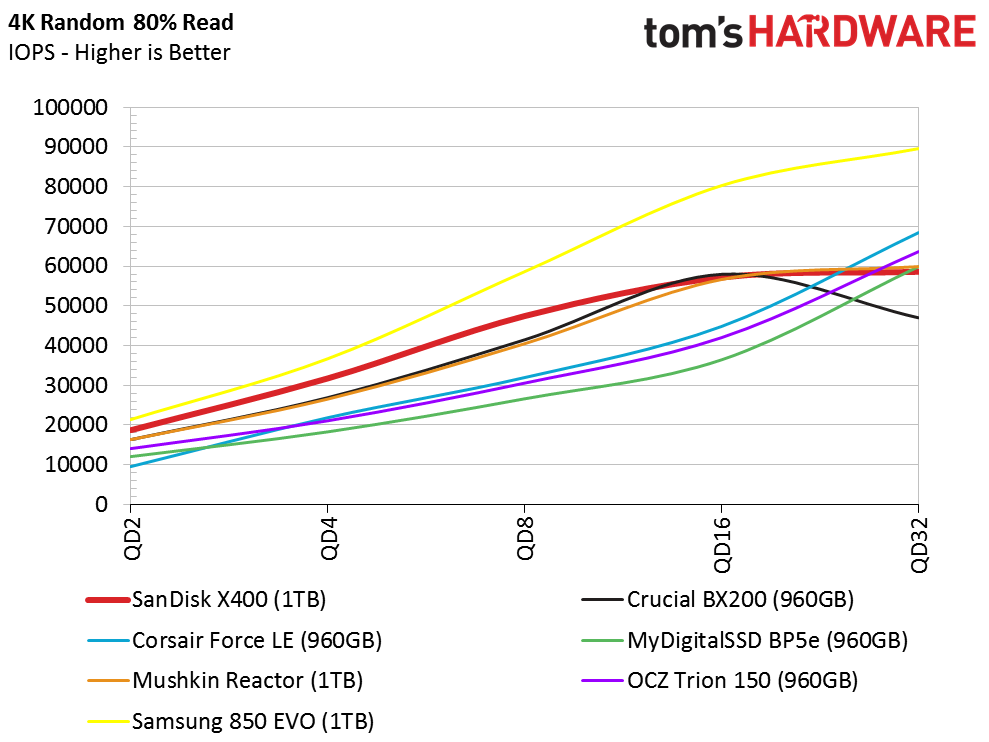SanDisk X400 1TB SSD Review
Why you can trust Tom's Hardware
Benchmarks And Comparisons
Comparison Products
We built a diverse group of low-cost SSDs to compare with the product under review. Our samples follow the latest market trends; all but one SSD utilizes three-bit per cell (TLC) flash.
The Samsung 850 EVO 1TB is the gold standard for entry-level to mainstream products. The SSD has been on the market for more than two years and it features the best software package on the market. Samsung's Magician software includes Rapid Mode, which is a system memory cache that buffers random data writes and flushes the data sequentially to the drive. The caching reduces flash wear and increases performance. It also features TurboWrite, which is an SLC-programmed buffer. The 850 EVO ships with a 5-year warranty. The 850 Evo's pricing often varies month-to-month, and it has steadily increased since the release of the 750 EVO series with planar TLC flash.
The Corsair Force LE, MyDigitalSSD BP5e and OCZ Trion 150 all use an 8-channel, feature rich controller co-developed by Phison and Toshiba. Corsair and OCZ offer average software packages, but both lack a system-level memory cache algorithm. Firmware updates on some products with this controller enable a new program mode that bypasses the SLC cache when the buffer is full. Direct-to-die writes nearly double sustained sequential write performance when the SSD operates outside of the SLC buffer, which is much better than previous program modes. These products include a 3-year warranty.
The Crucial BX200 and Mushkin Reactor both feature Silicon Motion controllers. The BX200 features Micron's 16nm TLC flash with an SLC program mode. The Reactor utilizes Micron's 16nm 128Gb MLC flash without an SLC programming mode. Crucial offers its Storage Executive SSD software package that features Momentum Cache, a DRAM cache function. These products carry a 3-year warranty.
Sequential Read Performance
To read about our storage tests in-depth, please check out How We Test HDDs And SSDs. Four-corner testing is covered on page six of our How We Test guide.
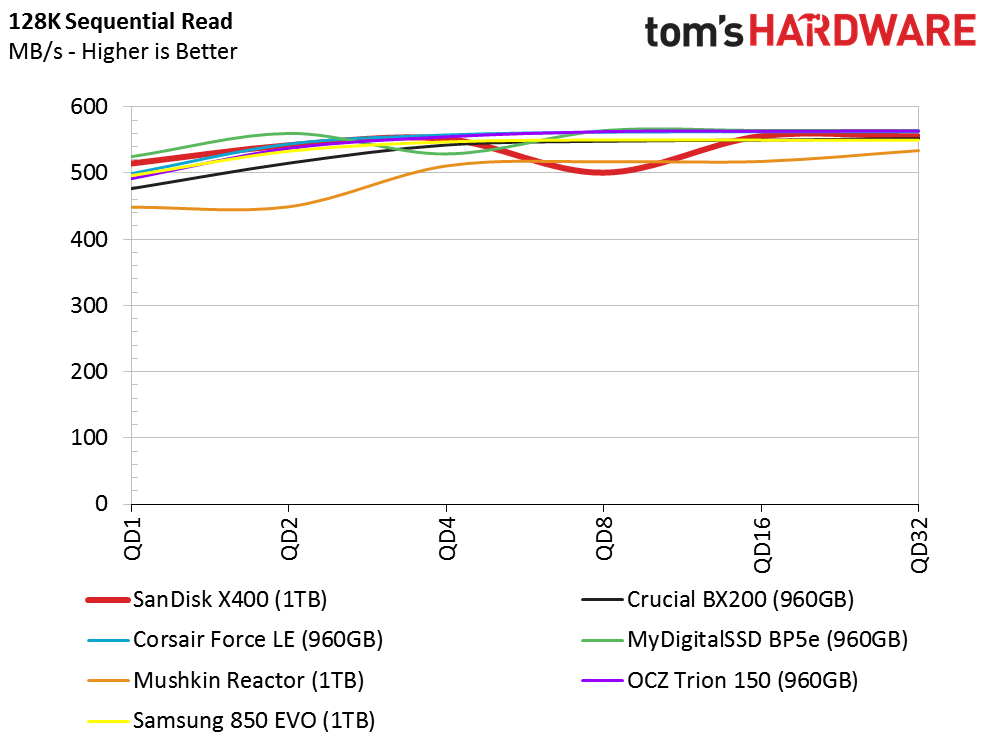
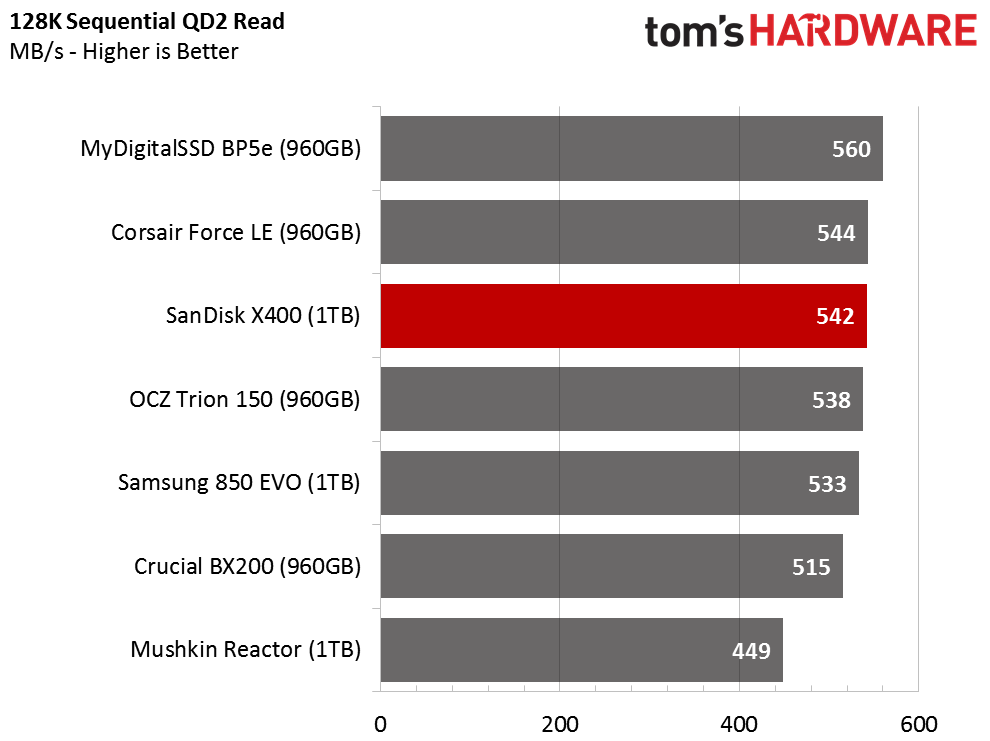
The Reactor is the only MLC-enabled SSD in the group of low-cost 1TB products, and it tailed the TLC drives in sequential read performance. Many users have been reluctant to adopt TLC SSDs. There was a good reason to wait when the technology first came to market, but modern TLC NAND is much better. The controllers that manage the flash are more powerful and have better error correction algorithms, which boost performance.
SanDisk's extensive experience with tuning Marvell controllers for high performance paid off with the X400 1TB. The drive is competitive in the sequential read portion of our review.
Get Tom's Hardware's best news and in-depth reviews, straight to your inbox.
Sequential Write Performance
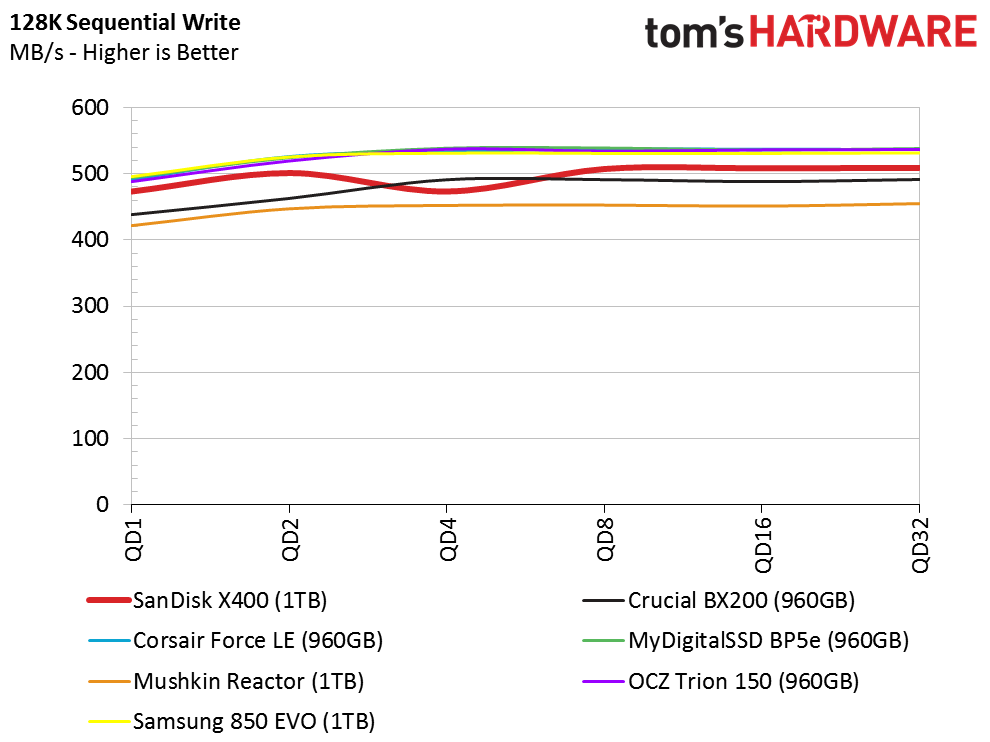
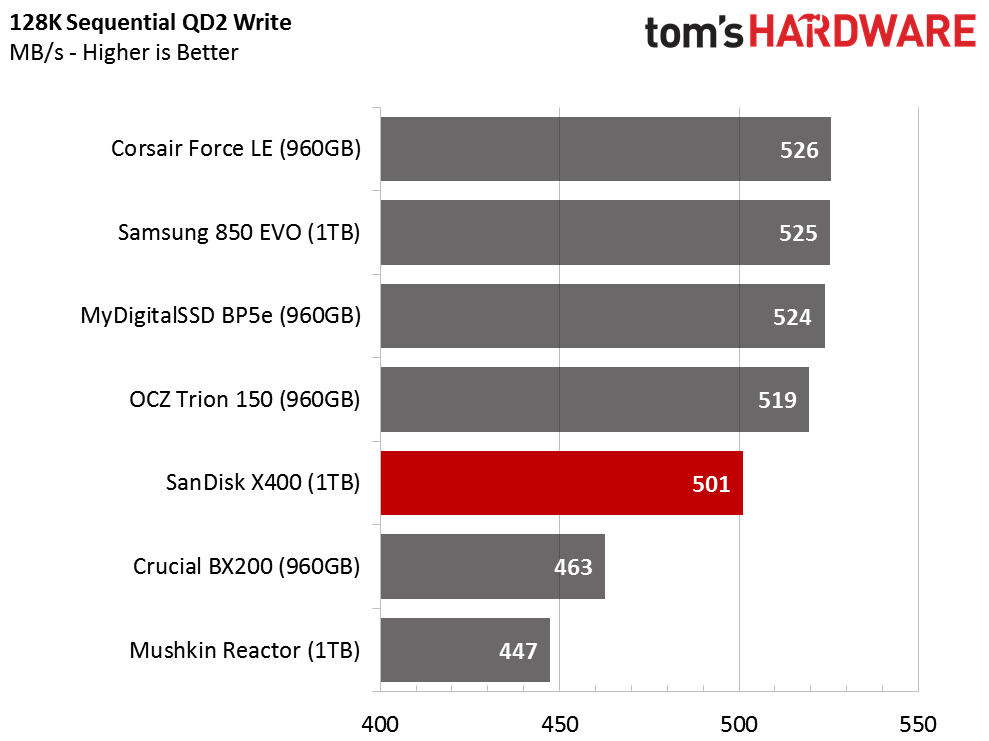
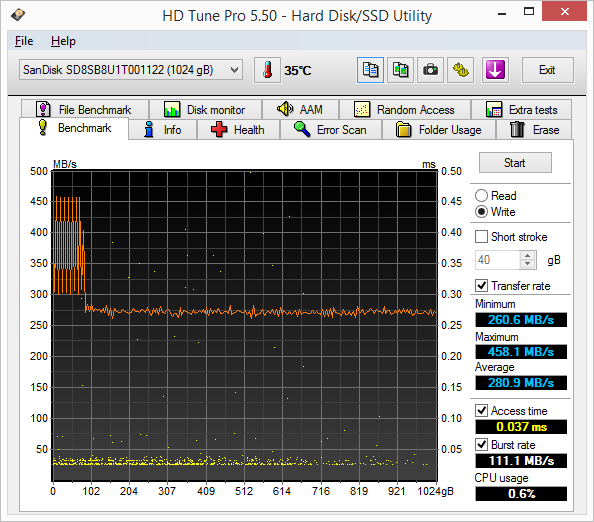
nCache 2.0 keeps sequential data writes moving at a high speed. The SLC cache buffer appears to flush the data quickly in our automated Iometer test. We didn't observe erratic behavior with any of the drives during the test. We used HD Tune Pro to write 128KB blocks across the full user LBA span of the drive, and the X400's native TLC write performance with this block size is right around 275 MB/s. It's not as fast as the Samsung 850 EVO 1TB, but it is faster than the first generation TLC-based products that came without direct-to-die algorithms.
Random Read Performance
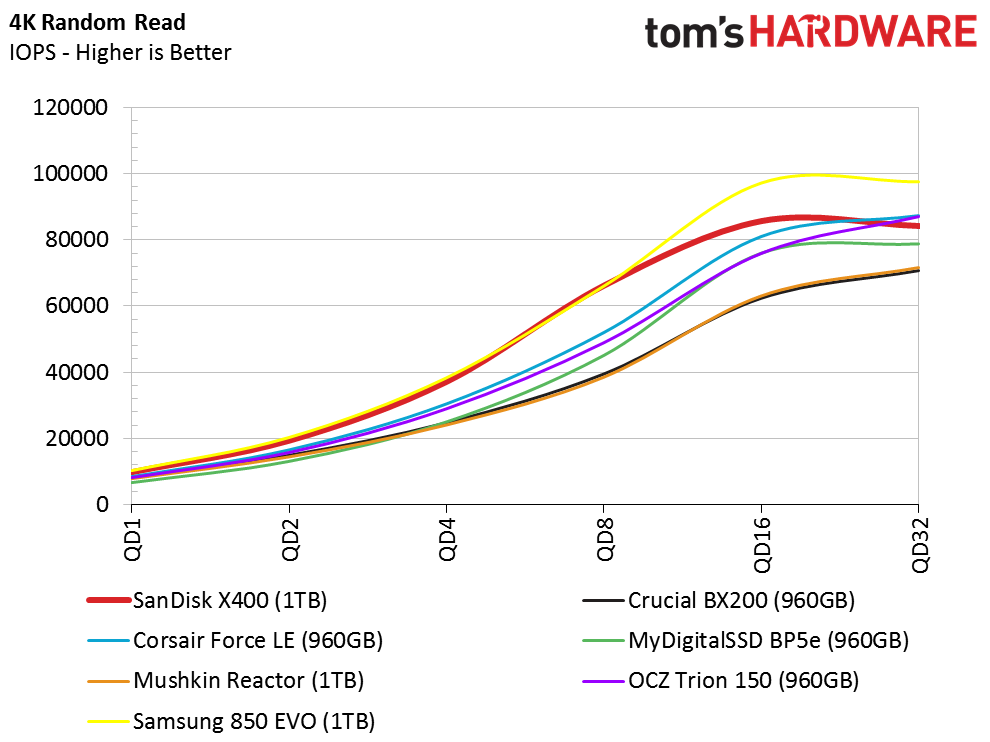
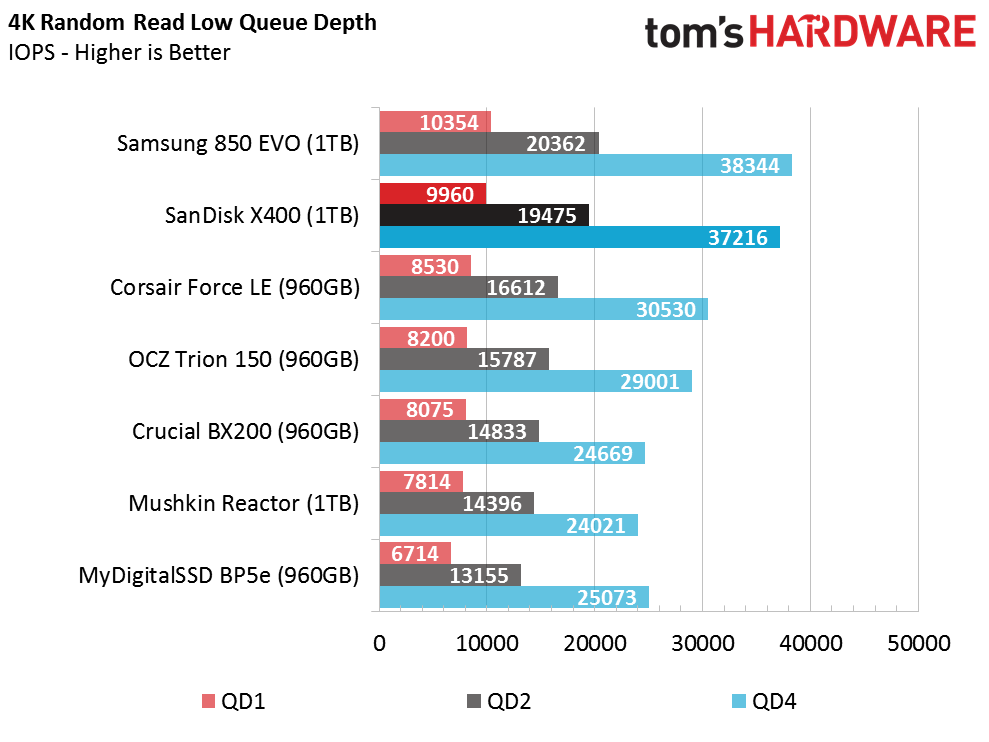
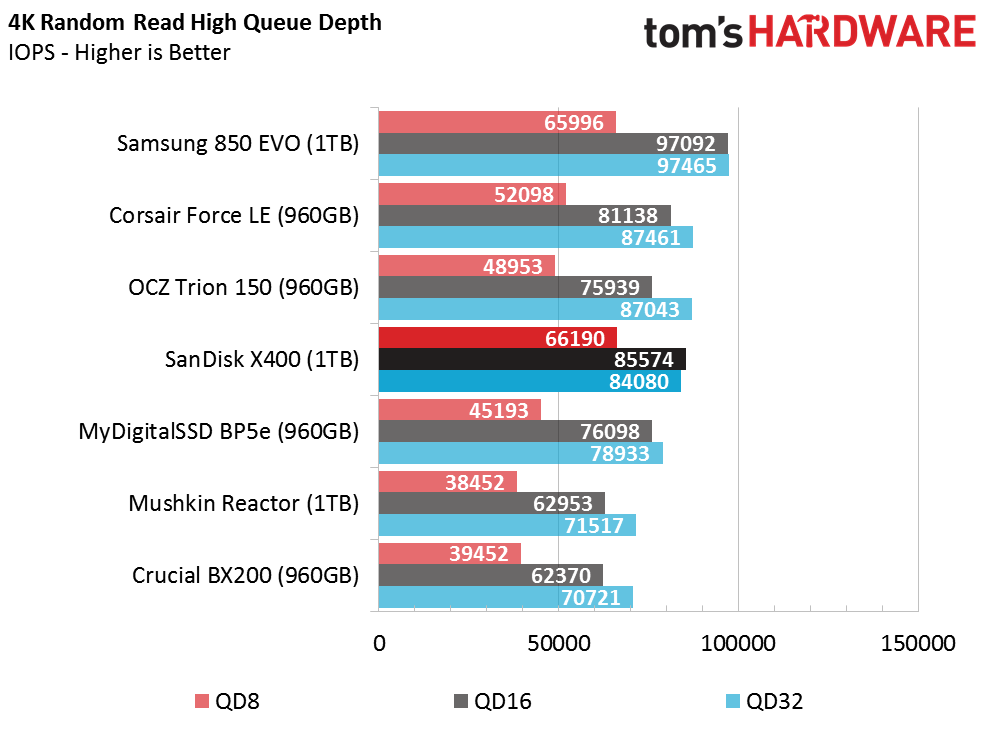
The X400 1TB trails only the Samsung 850 EVO 1TB in the random read tests at a queue depth of 1. The drive doesn't surpass the 10,000 random read IOPS mark at QD1, but it comes very close. The X400 scales well all the way up to QD16. The performance regresses slightly at QD32, but you will never reach that intensity under normal use, or even during heavy multitasking unless you are using the drive for virtualization.
Random Write Performance
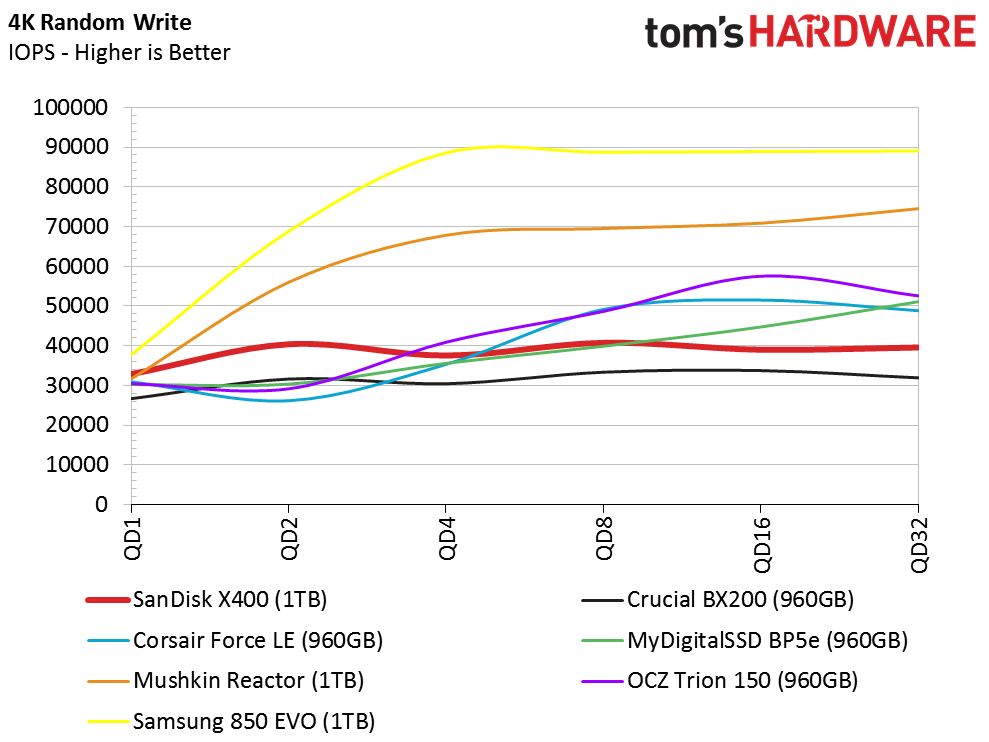
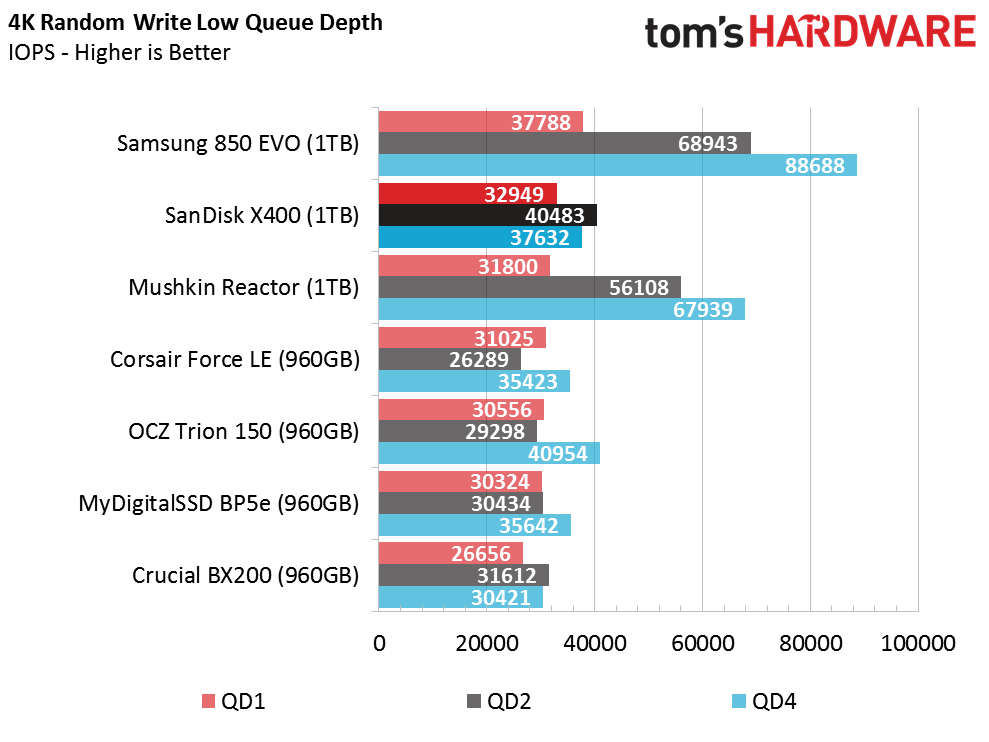
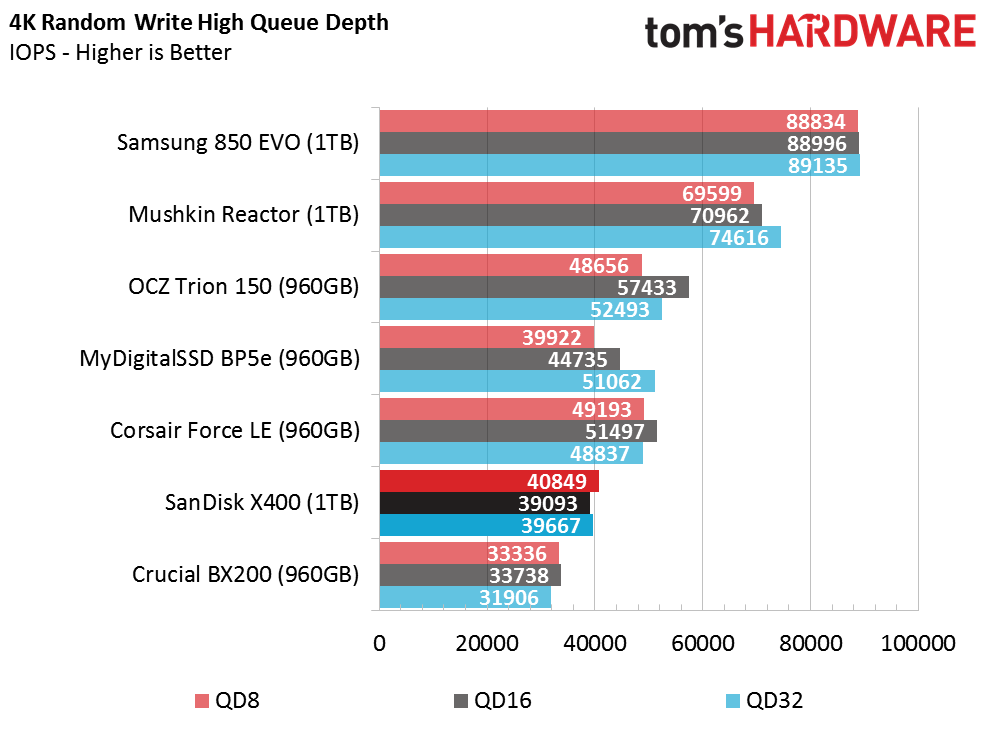
The X400 1TB delivers lower random write performance than the competition at every queue depth beyond QD1. The drive trails the Mushkin Reactor 1TB with MLC and Samsung 850 EVO with 48-layer TLC. The X400 slots in the middle of those two products at QD1, but quickly falls behind at higher queue depths.
80 Percent Sequential Mixed Workload
We describe our mixed workload testing in detail here, and describe our steady state tests here.
The SanDisk X400 1TB performs very well in our mixed workload sequential test, which is light enough that it does not push the drives down into steady state. At queue depths 2 and 4 (you can't have true mixed workloads at QD1), the X400 trails the Corsair Force LE 960GB and Crucial BX200 960GB by a small margin.
80 Percent Random Mixed Workload
The SanDisk X400 1TB trails only the Samsung 850 EVO 1TB during mixed random workloads until we reach very high queue depths. The X400 only trails the 850 EVO by a small amount in many of tests, so it will be interesting to see the real-world performance charts.
Sequential Steady-State

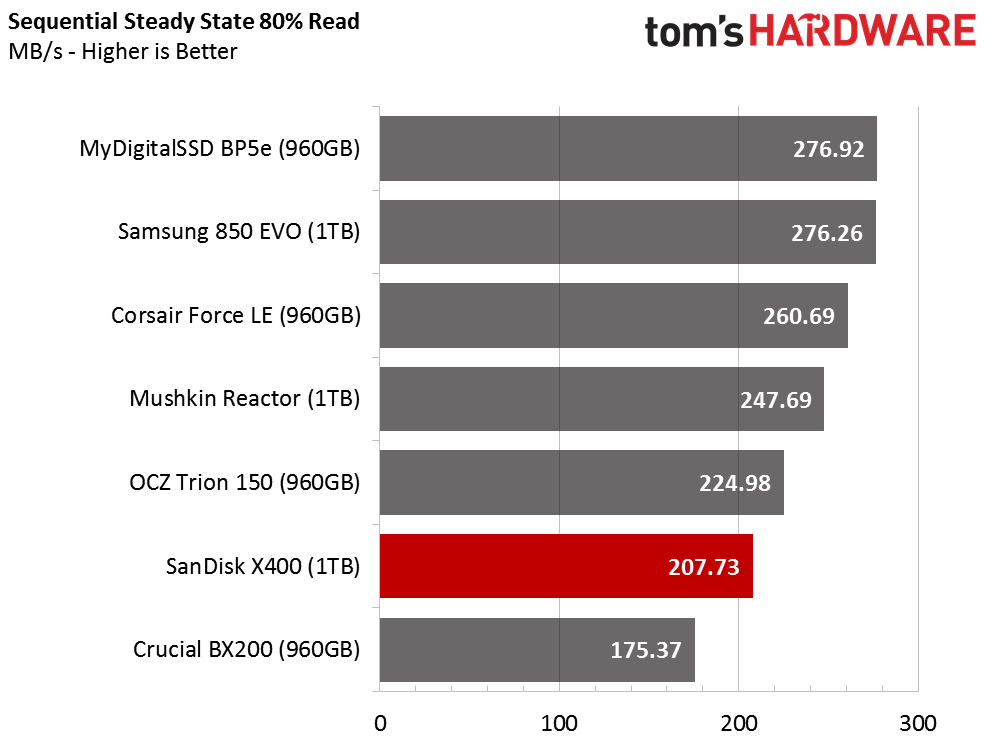
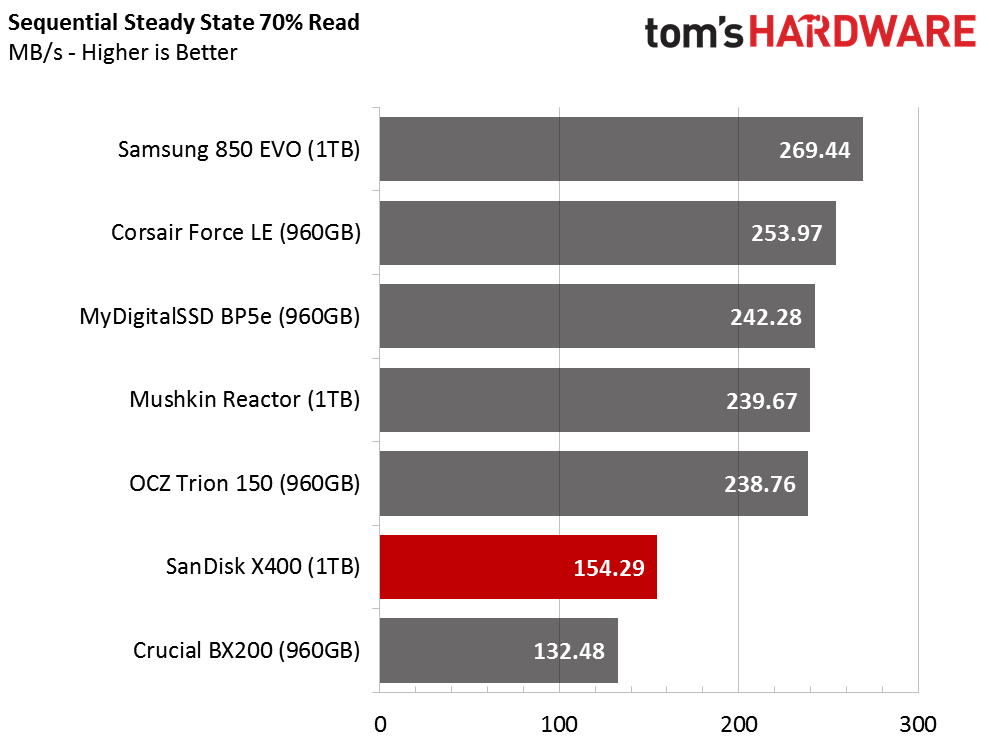
The SanDisk X400 1TB trails all but the Crucial BX200 960GB during most of the read/write mixtures used in the steady state test. The X400 is not the drive you want to use for write-heavy environments, such as editing high bit-rate video. The low endurance rating will keep most professional users from using the drive for this type of application.
Random Steady-State
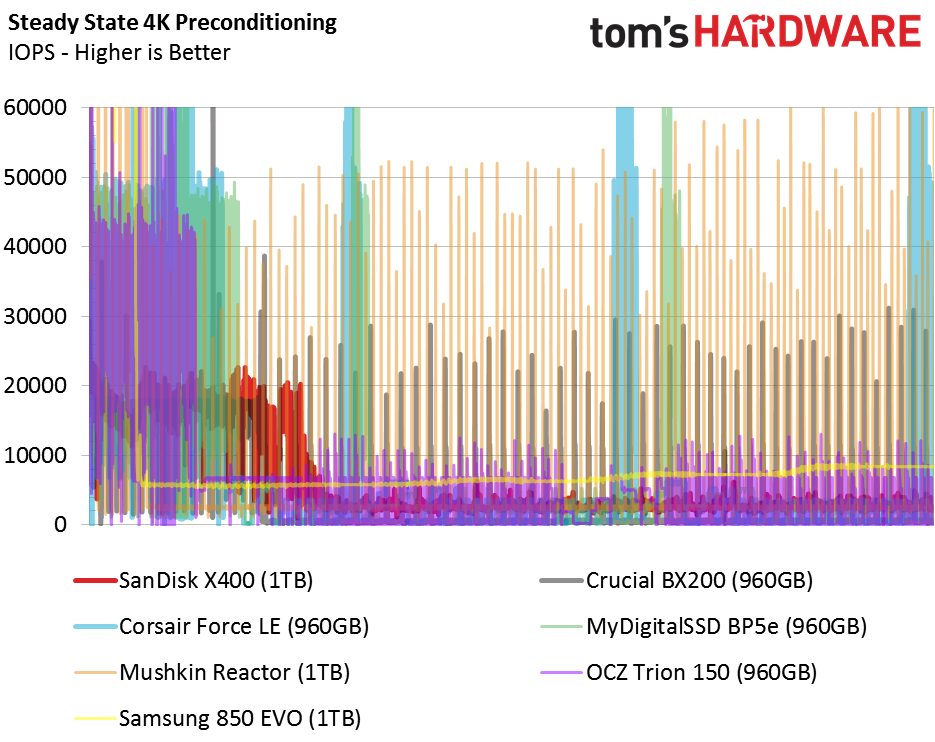
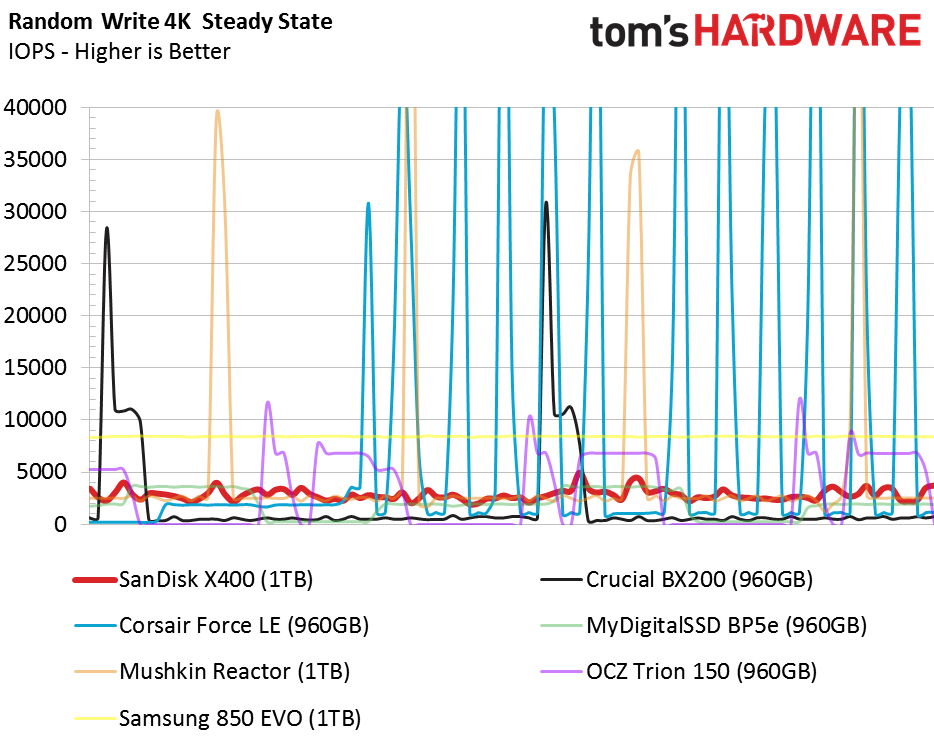
Most power users wouldn't willingly choose two entry-level SSDs to use in RAID 0. The X400 1TB SSD delivers consistent 4KB random data writes, but the sustained level is much lower than the mainstream 850 EVO and most of the current crop of premium SSDs.
Current page: Benchmarks And Comparisons
Prev Page Specifications And Features Next Page Performance And Conclusion
Chris Ramseyer was a senior contributing editor for Tom's Hardware. He tested and reviewed consumer storage.
-
LordConrad Planar TLC NAND under 20nm is crap. Under 20nm, only 3D NAND should be used.Reply
Personally, I prefer 3D NAND made on 20nm or higher lithography. -
rhysiam Reply18484754 said:Planar TLC NAND under 20nm is crap. Under 20nm, only 3D NAND should be used.
It's a budget option for sure, but looking at the numbers that drive pushes out it's a pretty compelling product. PCPartpicker at the moment has this drive for $240 (less than 25c/GB), compared to $310 for the 1TB 850 EVO. I'd save the $70 on the X400 myself.
I still want cheaper SSDs, particularly a cheap 2TB SSD so I can ditch mechanical storage altogether, and the price isn't there yet for me. 3D NAND is obviously superior, but it's still quite a bit more expensive too. I think it's positive that we're seeing planar TLC drives that actually perform decently, unlike the trashy BX200 and similar drives we saw a while back which just make too many sacrifices to be a viable option IMHO. -
HERETIC-1 Hi Chris,Reply
Do you know if Sandisk/WD flash that uses on chip copy/folding is any different to
Toshiba/OCZ flash? Or is it at controller/firmware level?
Talking about controllers-Sad to see the X400 die.
Do you have any feedback from manufacturers on the causes of SSD deaths?
If we were to look at Hardware France's No's and be generous and say a failure
rate of around 1%-That's millions of SSD's dying every year.(much less than HDD)
I'm guestimating controller or power components are the most likely.Bit sad that
a diode worth a few cents could brick a system............................ -
loki1944 I've got two X400 1TB SSDs and one X400 1TB M.2. SSD; great drives for a good price (at least in the US).Reply -
gondor Reply18484754 said:Under 20nm, only 3D NAND should be used.
There is no such thing as "under 20 nm 3D NAND". The key reason for 3D NAND being more reliable than current planar NAND is significantly larger lithography (40 nm class versus 10 nm class) which manufacturers can again afford due to its 3D structure.
-
DuncDog Chris,Reply
I just noticed this on the Service Time graphs. It appears that the metric is measured in seconds and not milliseconds. Surely, none of the SSDs have a service time exceeding 15 minutes. :P
I thought I was crazy on the Corsair SSD review a little while back, but it appears that it is present there as well. -
DuncDog OH!! I was going to ask something as well. In your time with the X400, did you ever experience any degree of suggestion from the software or Sandisk to overprovision some of the drive like Samsung does with the 840/850 EVOs? I know my 500 840Evo and 250 850Evo complain something fierce if I don't. Well Samsung Magician does at least.Reply
